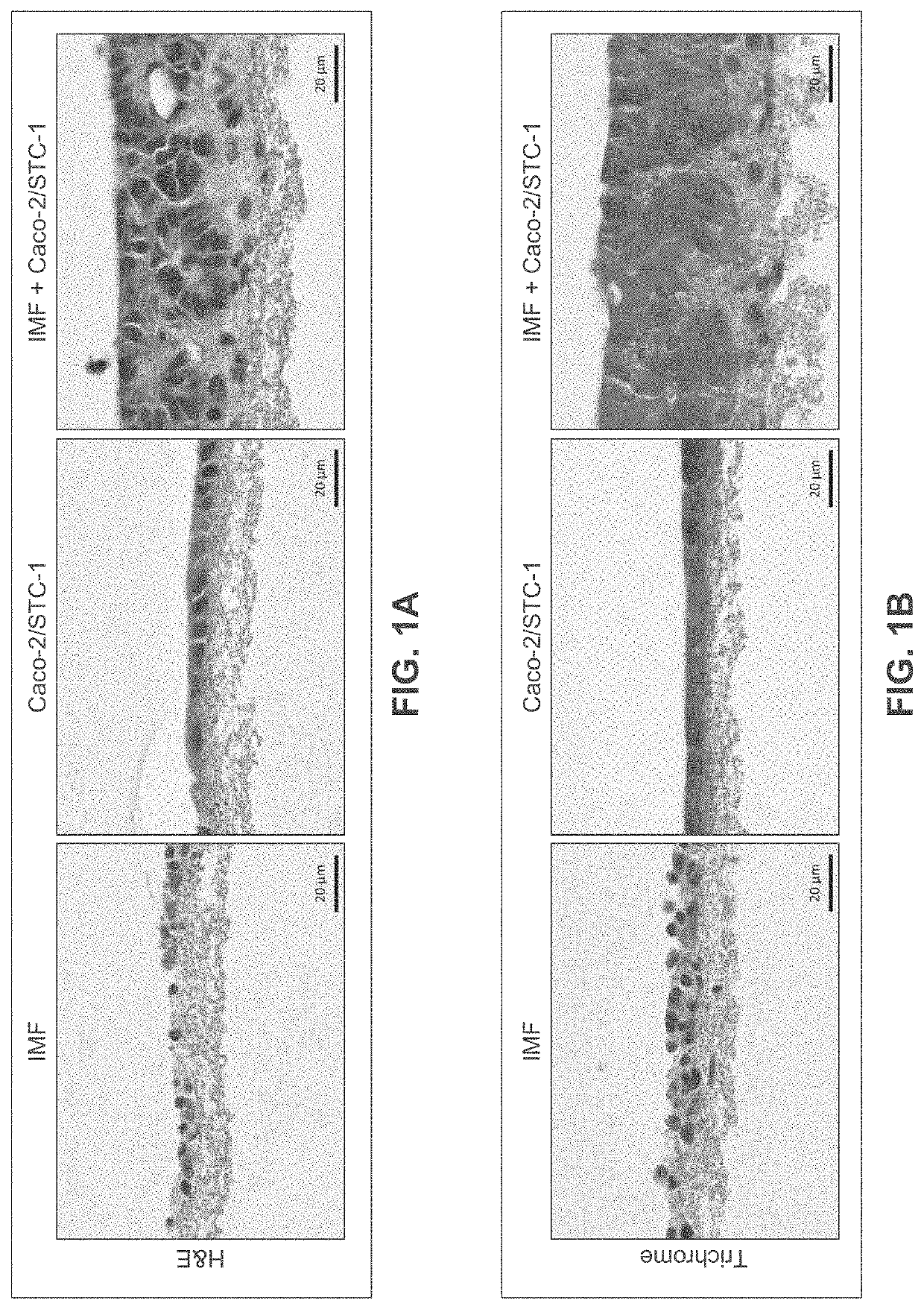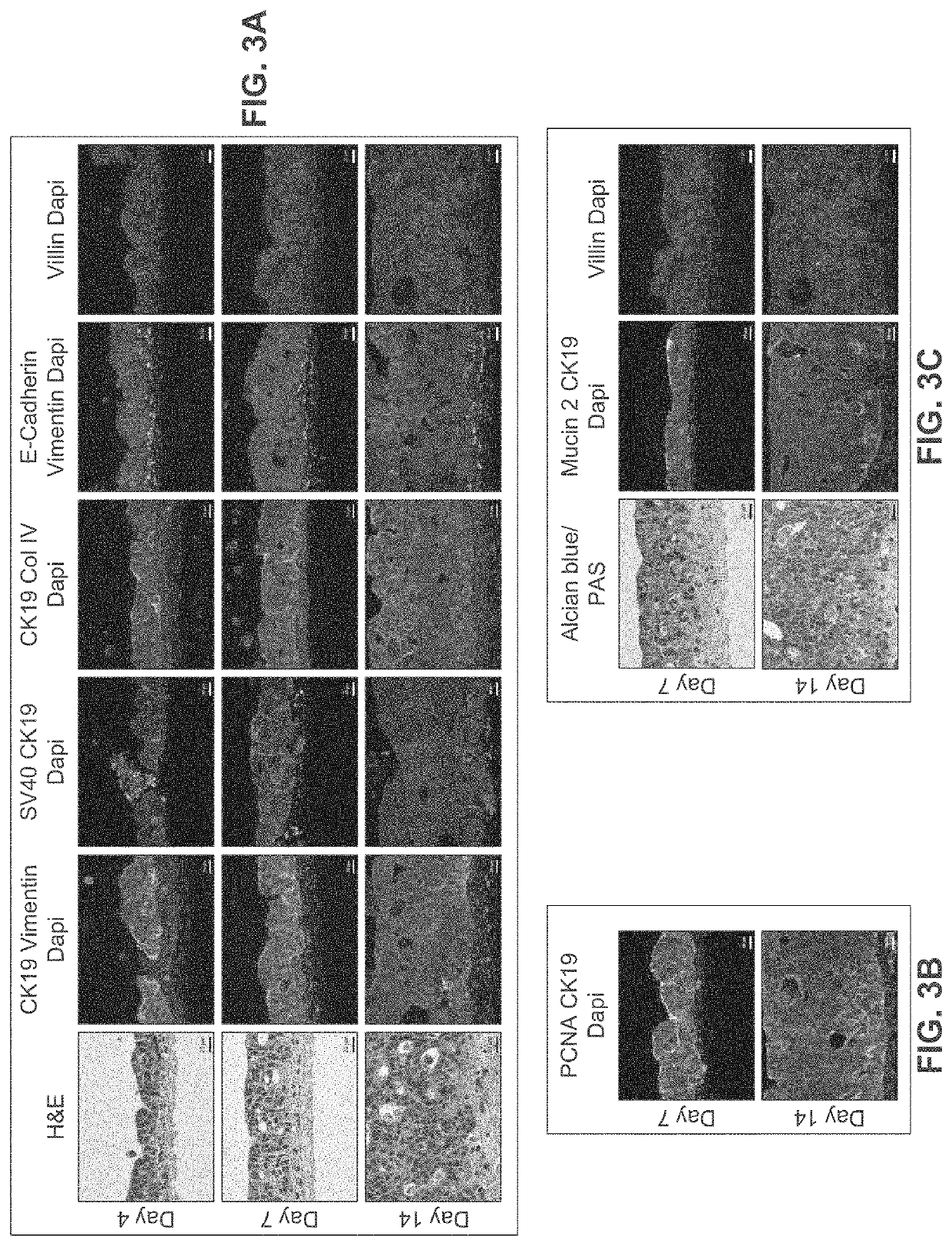Engineered Intestinal Tissue and Uses Thereof
a technology of intestinal tissue and engineering, applied in the field of intestinal tissue models, can solve the problems of low safety and efficacy predictability, drug development attrition, current preclinical models are limited in their ability to capture, and systemic availability
- Summary
- Abstract
- Description
- Claims
- Application Information
AI Technical Summary
Benefits of technology
Problems solved by technology
Method used
Image
Examples
example 1
A Manually Created Three-Dimensional Intestinal Tissue Model
[0288]Human intestinal tissue was fabricated with human primary intestinal cells and intestinal cell lines by continuous deposition using interstitial bio-ink containing gelatin and manual deposition of an epithelial suspension.
[0289]Bio-ink was generated by a cellular mixture of 100% primary adult human intestinal myofibroblasts (IMF) in 8% gelatin in a concentration of 20 million cells per milliliter. Three-dimensional bioink constructs were printed by continuous deposition using the Novogen MMX Bioprinter®. One tissue was printed per transwell in a 24 well plate. The transwell printing surface contained a polytetrafluoroethylene (PTFE) membrane coated with equimolar mixture of types I and III collagen (bovine) with pores 3 μm in size. Following printing, tissues were allowed to mature for 4 days in a humidified incubator in growth media. Tissues were cultured in 100% IMF media and media was changed daily. After incubatio...
example 2
A Bioprinted Three-Dimensional Intestinal Tissue Model
[0297]A human intestinal tissue construct was fabricated by bioprinting with 100% human adult primary intestinal cells by continuous deposition using interstitial bio-ink containing collagen followed by deposition of epithelial suspension.
[0298]Bio-ink was generated by a cellular mixture of 100% primary adult human intestinal myofibroblasts (IMF) in 100% bovine type I collagen at a concentration of 20 million cells per milliliter. Three-dimensional bio-ink constructs were printed by continuous deposition using the Novogen MMX Bioprinter® in a base layer to create an interstitial structure. One tissue was printed per transwell in a 24 well plate. The transwell printing surface contained a polytetrafluoroethylene (PTFE) membrane coated with equimolar mixture of types I and III collagen (bovine) with pores 3 um in size. Following printing, tissues were allowed to mature for 4 days in a humidified 37° C. incubator in 100% IMF media a...
example 3
A Bioprinted Three-Dimensional Intestinal Tissue Model Comprising Enteroendocrine Cells
[0307]A human intestinal tissue construct was fabricated with human adult primary intestinal cells and mouse enteroendocrine cell line STC-1 by continuous deposition using an interstitial bio-ink containing collagen and manual deposition of an epithelial suspension.
[0308]The interstitial layer was generated in an identical manner to Example 2. Bio-ink was generated by a cellular mixture of 100% primary adult human intestinal myofibroblasts (IMF) in bovine type I collagen at a concentration of 20 million cells per milliliter. Three-dimensional bioink constructs were printed by continuous deposition using the Novogen MMX Bioprinter® in a base layer with to create an interstitial structure. One tissue was printed per transwell in a 24 well plate. The transwell printing surface contained a polytetrafluoroethylene (PTFE) membrane coated with equimolar mixture of types 1 and III collagen (bovine) with p...
PUM
| Property | Measurement | Unit |
|---|---|---|
| time | aaaaa | aaaaa |
| thick | aaaaa | aaaaa |
| thick | aaaaa | aaaaa |
Abstract
Description
Claims
Application Information
 Login to View More
Login to View More - R&D
- Intellectual Property
- Life Sciences
- Materials
- Tech Scout
- Unparalleled Data Quality
- Higher Quality Content
- 60% Fewer Hallucinations
Browse by: Latest US Patents, China's latest patents, Technical Efficacy Thesaurus, Application Domain, Technology Topic, Popular Technical Reports.
© 2025 PatSnap. All rights reserved.Legal|Privacy policy|Modern Slavery Act Transparency Statement|Sitemap|About US| Contact US: help@patsnap.com



